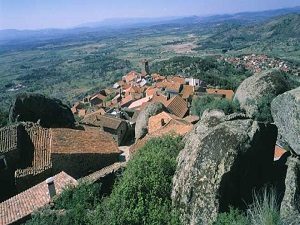The place that time forgot….Somewhere from out of the Flintstones……The most Portuguese village in Portugal… just some of the ways that March’s Place Of The Month is described by people.
 credit: visit portugal
credit: visit portugal
In actual reality this beautiful and fascinating little village, sat 758 metres above sea level in the municipality of Idanha-a-Nova, near the Spanish border is called Monsanto.
In 1938 it really was dubbed the most Portuguese village in Portugal and in 1955 it was also named as the most historical too. It has changed little since the 16th century and retained much of its medieval charm, many of the village houses are just as they would have looked originally, balanced high up in the hill and adapted perfectly to nestle around the huge granite boulders which Monsanto has become famous for. When building their houses, locals decided that rather than try to move them, they would instead build around, under and even dig into the huge 200 tonne rocks, some of the boulders even being used as roofs! This is boulder-chic Living at its finest!
 credit: visit portugal
credit: visit portugal
The views from Monsanto are something you have to see to believe, on a good clear day you can see for miles, the cobbled little winding streets transport you back to days gone by and if you have the energy and find yourself in Monsanto on a cool day you can climb to the top of the 400ft high peak where you’ll find square built castle which was granted to the Templar monks in 1165.
Monsanto (Mons Sanctus) has even shown evidence of human presence dating as far back as the Paleolithic Era. Archaeological evidence has also been found of a Lusitania fortress and of Roman, Visigoth and Arabian occupation too.
One of the most symbolic traditions of Monsanto is the Festival of the Holy Cross, held on the 3rd of May, to commemorate the resistance to a long history of sieges: the women carry to the top of the castle typical rag-dolls (known as “marafonas”) and clay jars full of flowers are thrown from the walls.





